Central Visayas Population in 2020 is relatively young
The region’s population remains relatively young as shown by the broad-based population pyramid in 2020. (Figure 1)
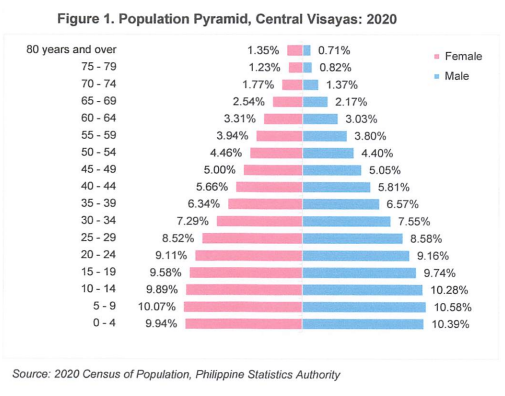
Of the 8.05 million household population in 2020, 4.08 million or 50.7 percent were males while 3.97 million or 49.3 percent were females. By age group, 2.46 million or 30.6 percent were under 15 years of age (young dependents). (Table 1)
On the other hand, persons aged 15 to 64 years (working-age or economically-active population) totaled to 5.11 million or 63.5 percent while those in age groups 65 years and over (old dependents) comprised the remaining 479.73 thousand or 6.0 percent.
(Table 1)
Moreover, there were more males (44.7 percent) than females (42.3 percent) among the 0 to 54 age group in 2020. Meanwhile, among the older age group (55 years and over), females (7.0 percent) outnumbered the males (6.0 percent). (Table 1)
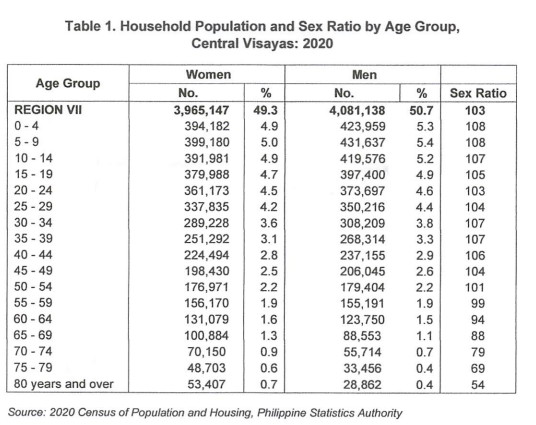
In 2020, there were more men (51.0 percent) than women (49.0 percent) among the youth in the region. Same trend was seen in all provinces except for the City of Cebu and City of Lapu-Lapu where youth women were more than the youth men. (Table 2)
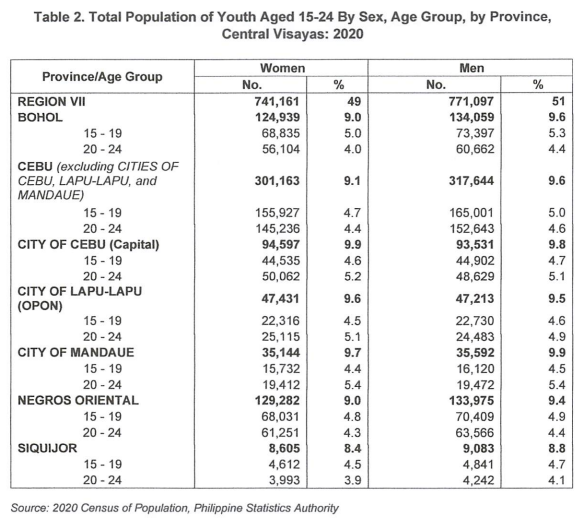
In 2020, more than half or 55.0 percent of the senior citizens in the region were women. In all age groups for senior citizens, population of women were relatively higher than men. (Figure 2)
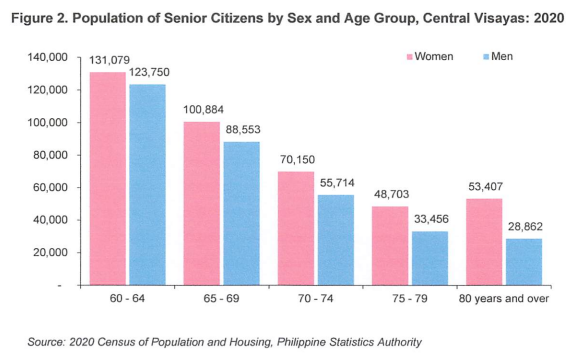
Women live longer than men
Females who are born between 2000 to 2040 are expected to live longer by 5 years than their male counterparts in Central Visayas. The life expectancy at birth for those born at this period is 75.1 years for female and 70.1 years for male. This is projected to improve further in 2035 to 2040 when life expectancy at birth is expected to rise to 78.9 years for females and 73.9 for males. The gap between the projected life expectancy between female and male is expected to narrow down from 5.3 in 2000-2005 to 5.0 in 2035-2040. (Figure 3)
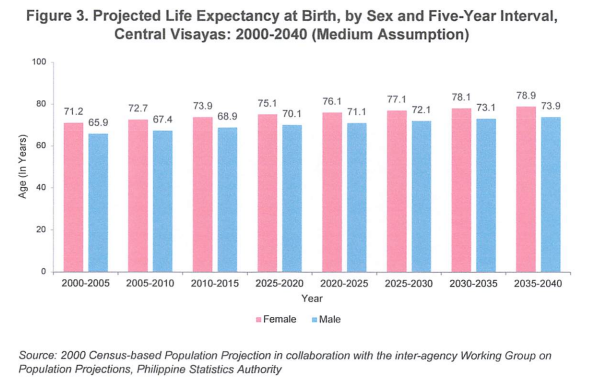
There are more economically active men than women in Central Visayas in 2021
Generally, there are more economically active men than women in Central Visayas in 2021. In 2021, 58.6 percent of men were in the labor force as compared to the 41.4 percent of women. (Table 3)
Of the employed persons in Central Visayas in 2021, 58.5 percent were men. This was higher by 17.0 percentage point compared to the total employed women of 41.5 percent. (Table 3)
Employment rate for women in Central Visayas was higher at 93 percent compared to that of men at 92.7 percent in 2021. Moreover, unemployment rate for men was higher compared to women with 7.3 percent and 7.0 percent, respectively. (Table 2)
Underemployment rate for men and women in 2021 stood at 16 percent and 12.5 percent, respectively. (Table 3)
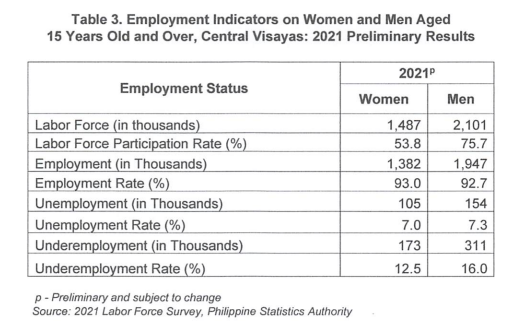
More single men than women in Central Visayas
Of the household population 10 years and over in 2020, there were more single men than women in the region with 54.3 percent and 45.7 percent, respectively. However, women outnumbered men among married, widowed, common-law/live-in and divorced/separated population. (Table 4)
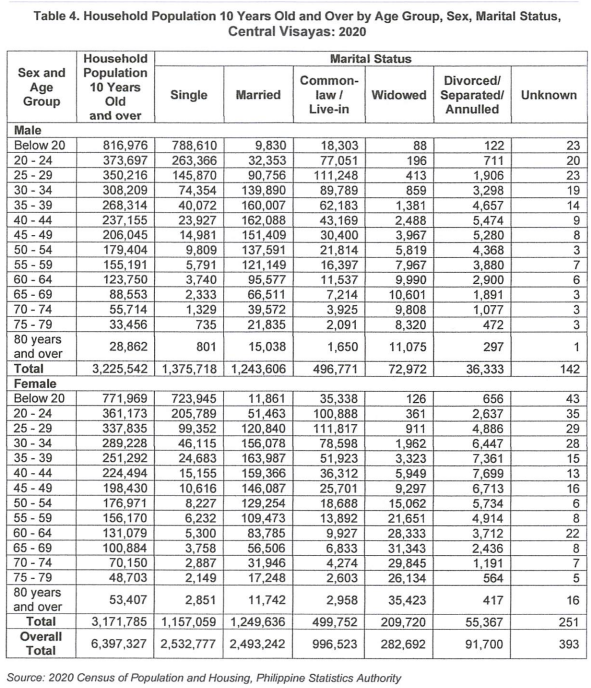
More women are literate than men in 2019
In 2019, women posted simple literacy rate of 96.9 percent. This figure is higher compared to that of men at 94.8 percent. Consequently, women had higher functional literacy rate at 91.0 percent compared to that of men at 87.2 percent. (Figure 4)
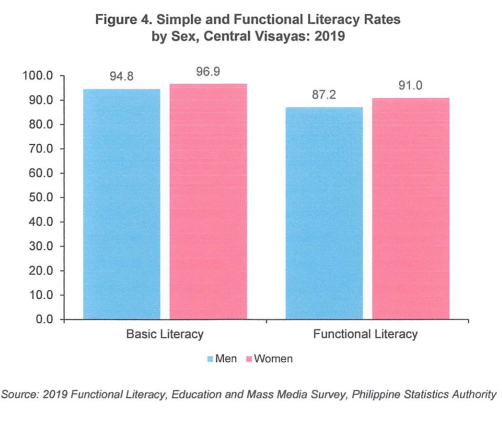
Simple literacy rate among women in Central Visayas increased by 1.31 percentage points while those of men decreased by 0.18 percentage points, respectively, from 2008 to 2019. The literacy rate for women improved from 95.60 percent in 2008 to 96.91 percent in 2019, while the literacy rate for men also increased from 94.60 percent to 94.78 percent in the same period. It can be noted that, however, the literacy rate among women has been consistently higher than men from 2008 to 2019. (Figure 5)
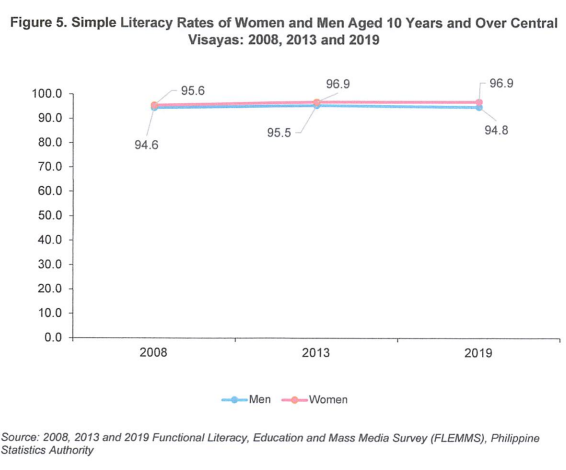
In terms of functional literacy, women in Central Visayas achieved higher functional literacy rate than men from 2008 to 2019. In general, both functional literacy rates of women and men improved from 2008 to 2019. (Figure 6)
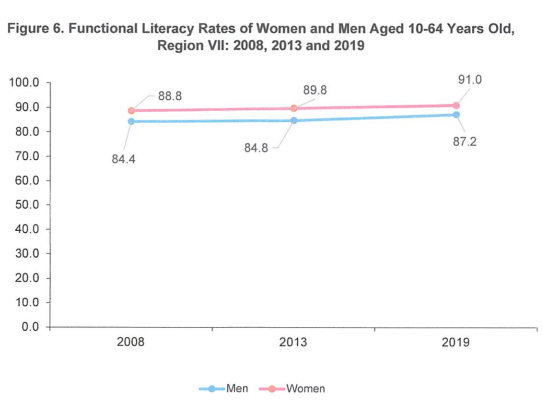
Generally, basic literacy rates of women by age group in Central Visayas were higher compared to men except the age group of 50-59 in 2008, 2013 and 2019, age group of 60 and over in 2008, and age group of 20-24 in 2008. (Table 5)

Functional literacy rates of women by age group in Central Visayas were higher than that of men except for age group 60 and over in 2008 and 2009. In 2013, women functional literacy rates were higher at all age groups compared to men. Functional literacy rate of women at age group 25 – 29 was the highest among women age groups at 96.8 percent in 2019. Furthermore, age group 20-24 among men recorded the highest functional literacy at 95.8 percent in 2019. (Table 6)
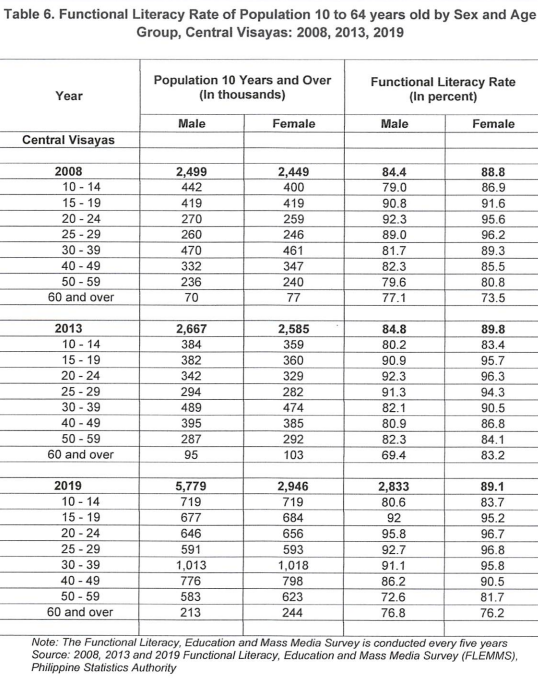
More men were enrolled in both basic public and private schools and TVET Programs, more women are enrolled in tertiary education
There were more males (51.9 percent) than females (48.1 percent) enrolled in public elementary schools in the region during S.Y. 2020-2021. Moreover, there were more males (50.6 percent) than females (49.4 percent) enrolled in public secondary schools of the same school year. (Table 7)
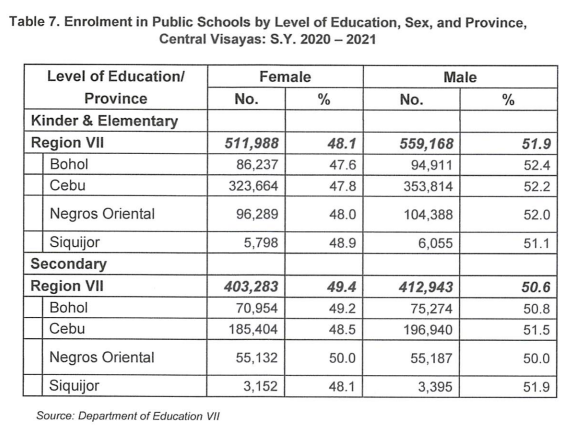
There were more male (51.2 percent) than female (48.8 percent) enrolled in private elementary schools in the region during S.Y. 2020-2021. However, there were more female enrolled in private secondary schools with 50.1 percent compared to male with 49.9 percent in the same school year. (Table 8)
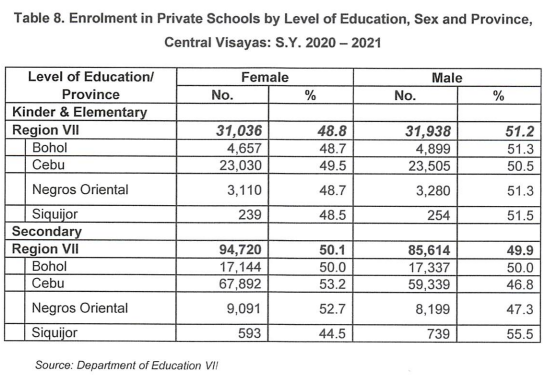
In Central Visayas, more women were enrolled in Tourism (including Hotel and Restaurant) programs in C.Y. 2020 with enrollment rate of 32.6 percent among women. The same program where more men were enrolled at 22.3 percent among men.
In general, there were more men graduates of Technical and Vocational Education and Training Programs compared to women in C.Y. 2020. However, there were more women TVET program graduates in Tourism (Including Hotel and Restaurants), Health, Social & Other Communication Development Services, Agriculture and Fishery, Processed Food and Beverages, Garments, and Communication/Information Technology compared to men. (Table 10)
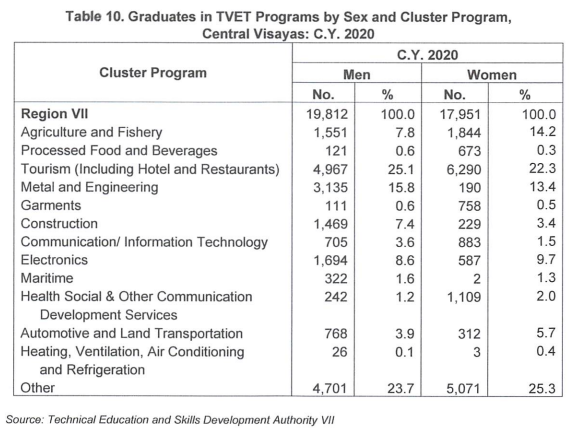
In Central Visayas, more women were enrolled in Business Administration and Related in A.Y. 2020-2021 with an enrollment rate of 22.3 percent. On the other hand, more men were enrolled in Engineering with 27.7 percent in A.Y. 2020-2021. (Table 11)

In Central Visayas, more males graduated in Engineering Course with a rate of 25.34 percent in A.Y 2020-2021. On the other hand, more females graduated in Business Administration and Related with 22.85 percent in A.Y 2020-2021. (Table 12)
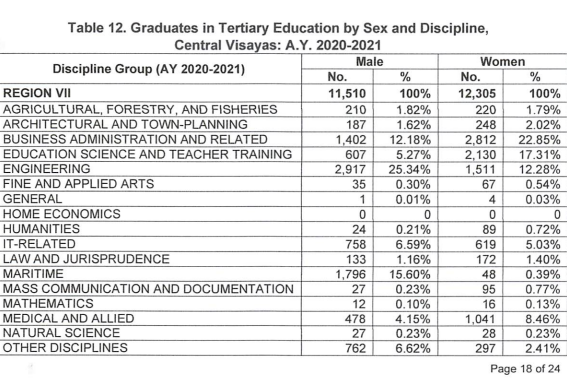
Approved by:
ARIEL E. FLORENDO
Regional Director
Technical Notes
Age Dependency Ratio
-is the ratio of persons in the "dependent" ages (generally under age 15 and over age 64) to those in the "economically productive" ages (15-64 years) in the population. It is sometimes divided into the old-age dependency (the ratio of people aged 65 and older to those aged 15-64 years) and the child dependency (ratio of people under 15 to those aged 15-64 years).
Employed
-include all persons 15 years old and over as of their last birthday and during the basic survey reference period are reported as either: a) At work. Those who do any work even for one hour during the reference period for pay or profit, or work without pay on the farm or business enterprise operated by a member of the same household related by blood, marriage, or adoption; or b) With a job but not at work. Those who have a job or business but are not at work because of temporary illness/injury, vacation, or other reasons. Likewise, persons who expect to report for work or to start operation of a farm or business enterprise within two weeks from the date of the enumerator's visit, are considered employed.
Employment Rate
-Percentage of the total number of employed persons to the total number of persons in the labor force.
Employment – to – Population Ratio
-Ratio of employed persons to the total population 15 years old and over
Functional Literacy
-is a significantly higher level of literacy which includes not only reading and writing but also numeracy skills. The skills must be sufficiently advanced to enable the individual to participate fully and efficiently in activities commonly occurring in his life situation that require a reasonable capability of communicating by written language. A functional literate person is one who can at least read, write, compute and/or comprehend. Also, persons who graduated from high school or completed higher level of education are classified as functionally literate.
Highest Grade/Year Completed
-Highest grade/year completed refers to the highest grade or year completed in school, college, or university. This may be any one of the specific grades or years in elementary, high school, post-secondary school, college, and post baccalaureate levels of schooling. It also includes preschool education.
Household
-a social unit consisting of a person living alone or a group of persons who sleep in the same housing unit and have a common arrangement in the preparation and consumption of food.
Household Population
-the population enumerated in private households during a census.
Person in the Labor Force
-the population 15 years old and over whether employed or unemployed who contribute to the production of goods and services in the country.
Labor Force Participation Rate
-Percentage of the total number of persons in the labor force to the total population 15 years old and over.
Life Expectancy
-represents the average number of years remaining to a person who survives to the beginning of a given age or interval x.
Occupation
-Type of work a person does to earn his living.
Notes:
-The following are the major occupation groups: officials of government and special-interest organizations, corporate executives, managers, managing proprietors and supervisors; professionals; technicians and associate professionals; clerks; service workers and shop and market sales workers; farmers, forestry workers and fishermen; trades and related workers; plant and machine operators and assemblers; laborers and unskilled workers; and special occupations. This term is used for disaggregating other labor and employment measures, e.g., total number of employed persons by major occupation groups.
Overseas Filipino Worker (OFW)
-a Filipino worker who is to be engaged, is engaged, or has been engaged in a remunerated activity in a country of which he/she is not a legal resident.
Population
-total number of individuals in a territory at a specified time. It covers both nationals and aliens, native- and foreign-born persons, internees, refugees and any other group physically present within the borders of a country at a specified time. In assembling national demographic statistics for publication, the basic aim has been to obtain data for the physically present (or de facto) population rather than for the legally established resident (or de jure) inhabitants.
Population Growth Rate
-indicates how fast a population increases or decreases as a result of the interplay of births, deaths, and migration during a given period of time. Where the population is closed, meaning no migration, the population growth rate is the same as the rate of natural increase, i.e., the difference between the number of births and the number of deaths during a specified period of time. The three methods for computing the rate of growth based on the assumption with respect to the change are: arithmetic change, geometric change and exponential change.
Population Projection
-computation of future changes in population numbers, given certain assumptions about future trends in the rates of fertility, mortality and migration. Demographers often publish high, medium, and low projections of the same population based on different assumptions of how these rates will change in the future.
Simple Literacy
-is the ability of a person to read and write with understanding a simple message in any language or dialect.
Simple Literacy Rate
-the percentage of population which can read and write a simple message in any language or dialect.
Unemployed
-The unemployed include all persons who are 15 years old and over as of their last birthday and are reported as:
-without work, i.e., had no job or business during the basic survey reference period;
-and currently available for work, i.e., were available and willing to take up work in paid employment or self-employment during the basic survey reference period, and/or would be available and willing to take up work in paid employment or self-employment within two weeks after the interview date;
-and seeking work, i.e., had taken specific steps to look for a job or establish a business during the basic survey reference period;
-or not seeking work due to the following reasons:
-tired/believe no work available, i.e., the discouraged workers who looked for work within the last six months prior to the interview date;
-awaiting results of previous job application;
-temporary illness/disability; (d) bad weather; and (e) waiting for rehire/job recall.
Unemployment Rate
-Percentage of the total number of unemployed persons to the total number of persons in the labor force.
Work
-Any activity that a person does during the reference period, for pay in cash or in kind, in any establishment, office, farm, private home, or for profit or without pay on a family farm or enterprise. It also includes:
-what a farm operator or member of the operator's family does on the farm operated by another household on exchange labor arrangement; and
-any activity that a person does in relation to minor activities in home gardening, raising of crops, fruits, hogs, poultry, etc., fishing for home consumption and manufacturing for own use. However, there must be some harvest in the case of home gardening, raising of crops, fruits and nuts, and gathering of wild fruits and vegetables; animals disposed of (sold, consumed, bartered, or given away), or some catch in fishing in order that these activities will be considered work.

